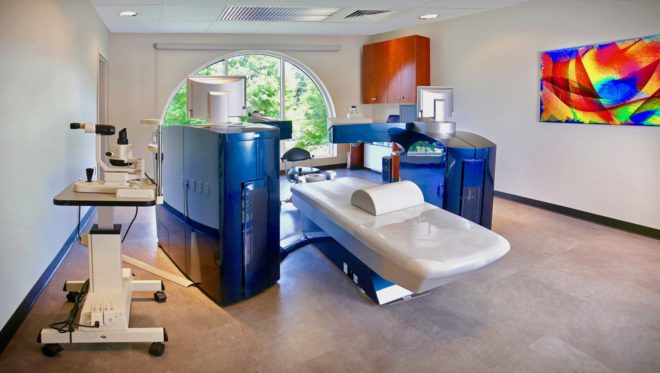
Providence Eye's Laser Suite
At Providence Eye & Laser Specialists, we take pride in continually investing in the most up-to-date, proven, leading-edge LASIK technology that delivers the best possible outcome for our patient’s unique needs. That is why we only perform blade-free, all-laser LASIK surgery utilizing complementing lasers: the WaveLight FS200 and the WaveLight EX500 Lasers.
From start to finish, our goal is to ensure that our patients are comfortable and confident in their understanding of the all-laser LASIK technology that will be utilized during their vision correction procedure and the overall cost of LASIK eye surgery.
At Providence Eye, we invest in proven, leading-edge technology. Mapping your cornea is a critical step in determining if you are an ideal LASIK candidate. We use the Sightmap device, which is the most advanced corneal mapping system available today. Each person’s eye processes light differently and has a different curvature; the mapping is unique to each patient just like their fingerprint.
Creating the corneal flap is the first step of all-laser LASIK eye surgery. Utilizing a laser rather than a microkeratome (blade) is truly paramount to producing optimal long-term results. Although it is industry standard to make the flap with a laser as opposed to a blade, there are practices in the Carolinas still utilizing a blade. Dr. Nunnery creates the corneal flap using the WaveLight FS200 Laser.
Reshaping the cornea is the second step of all-laser LASIK eye surgery, and the step when your vision is corrected. To reshape the cornea, Dr. Nunnery utilizes all the data that was gathered during the LASIK consultation, specifically your corneal mapping. The information obtained from the Sightmap device shows your surgeon a 3D model of your eye so he can determine how to reshape it. The flap is gently opened, exposing the underlying tissues of the cornea, which can then be reshaped using the WaveLight EX500 Laser.
All-laser LASIK eye surgery was introduced in 2002 and has proven to be a safer, more precise and more predictable method for LASIK vision correction. Millions of procedures have been performed worldwide using all-laser LASIK technology. It is now accepted as the safest and most accurate technique compared to blade LASIK eye surgery, which has more risks involved.
All-laser LASIK is also known as I-LASIK and Z-LASIK. These procedure names are dependent on the laser manufacturer. It is important to understand which lasers are being recommended specifically for you, the patient. Unlike Providence Eye & Laser Specialists, some LASIK practices have multiple “levels” of LASIK technology. Although they may highlight their best technology, you may learn that your procedure would be done with a different, possibly older laser or maybe even a blade. It's important to understand the differences between LASIK technology and the expertise of the LASIK surgeon utilizing the technology.
Schedule online, call 704-540-9595 or complete the short form below and we will call you.